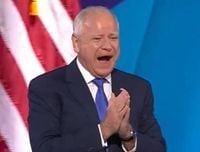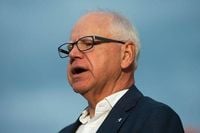The political temperature in the United States soared this week as Minnesota Governor Tim Walz faced a torrent of criticism for remarks widely interpreted as expressing hope for President Donald Trump’s death. The controversy erupted at a Labor Day event in Duluth on September 1, 2025, where Walz, referencing recent social media rumors about Trump’s health, told supporters, “The last few days, you woke up thinking there might be news. Just saying. Just saying. There will be news sometime, just so you know. There will be news.” According to the Daily Caller, these comments ignited immediate outrage across social media and the political spectrum, with critics accusing the Democratic governor of crossing a grave line.
The timing of Walz’s remarks only added fuel to the fire. In the preceding week, Minnesota had been rocked by the tragic shooting of schoolchildren in a church, a fact many online commentators highlighted as evidence of Walz’s misplaced priorities. As reported by MEAWW, social media users were swift and unsparing in their condemnation. One user wrote, “This is disgusting @GovTimWalz. I’ll remind you that @POTUS was nearly assassinated a few times. What kind of leader cheers for the death of political opponents? Gross and vile.” Another, echoing the outrage, asked, “Why are Democrats so filled with hate?” The backlash was not limited to anonymous voices online; prominent conservative figures and Republican officials quickly joined the chorus.
Texas Senator Ted Cruz, never one to shy away from a political fight, shared a video of Walz’s remarks on X (formerly Twitter), writing, “Sick bastard openly rooting for the President’s death. This is today’s Democrat party.” According to the Irish Star, Cruz’s post amplified the controversy, drawing further attention and sparking debate about the boundaries of political rhetoric. Meanwhile, Republican strategist Scott Jennings, during a panel on “The Arena With Kasie Hunt,” launched a scathing critique of Walz. “I used to say he was the biggest buffoon in American politics, but it’s worse now. No political official, no elected official should be walking around saying ‘Why, I’m hoping we wake up one day, and the president of the United States has died.’ Crazy,” Jennings declared, as quoted by the Daily Caller. Jennings did not mince words, labeling Walz a “complete piece of shit.”
The context for Walz’s remarks was a swirl of online conspiracy theories that had emerged days earlier. Starting around August 29, 2025, hashtags like #TrumpIsDead and #WhereIsTrump trended on social media, fueled by Trump’s brief public absence. According to RealClearInvestigations, the speculation grew so intense that even Illinois Governor JB Pritzker, responding to Trump’s criticism of Chicago crime, quipped online, “Why don’t you send everyone proof of life first?” It was a moment that underscored the fever pitch of rumor and innuendo dominating political discourse.
Trump himself addressed the rumors head-on during his first public appearance in a week, at the Space Command headquarters announcement on September 2, 2025. Fox News’ Peter Doocy asked him, “How did you find out over the weekend that you were dead? Did you see that?” Trump, ever blunt, replied, “No.” The 79-year-old president went on to explain that he was aware of concerns about his condition but dismissed the rumors as “fake news,” insisting, “I was very active over the weekend.” He detailed visits to his golf club near the Potomac River and pointed to his 90-minute interview with The Daily Caller’s Reagan Reese on August 29 as evidence of his continued engagement. “Last week, I did numerous news conferences, all successful. They went very well, like this is going very well. And then, I didn’t do any for two days, and they said, ‘There must be something wrong with him.’ Biden wouldn’t do them for months. You wouldn’t see him, and nobody ever said there was ever anything wrong,” Trump said, highlighting what he perceives as a double standard in media coverage.
As the rumors faded, attention turned to Trump’s visible health. In recent weeks, observers noted bruising on the back of his right hand—sometimes awkwardly concealed with makeup—and swelling around his ankles. The White House, seeking to quell speculation, revealed that Trump has chronic venous insufficiency, a condition that impairs blood flow from the legs back to the heart, leading to swelling. Press secretary Karoline Leavitt attributed the bruising to “frequent handshaking and the use of aspirin,” which Trump reportedly takes to reduce his risk of heart attack and stroke. The Mirror US reported that this is a relatively common condition among older adults, and the White House’s transparency on the issue contrasted with past secrecy. For instance, during Trump’s 2020 Covid-19 hospitalization, key details about his health were withheld, only surfacing later when it became clear his illness was more severe than initially reported.
Despite the swirl of rumors, Trump sought to project vitality and confidence. On August 31, 2025, he posted on Truth Social, his proprietary platform, “NEVER FELT BETTER IN MY LIFE.” According to the Irish Star, Trump also referenced his activity on social media during his brief public absence, noting he had composed some “long Truths” and “pretty poignant Truths.” Historically, Trump has been reluctant to release detailed health information, preferring instead to tout his vigor with superlatives. After his initial 2015 campaign announcement, he released a letter from his physician boasting that “his physical strength and stamina are extraordinary” and that he would be “the healthiest individual ever elected to the presidency.”
Yet the heart of the controversy remained Walz’s remarks and the broader implications for American political discourse. Conservatives argued that had a Republican official made similar comments about a Democratic president, the media reaction would have been far more intense. Mark Hemingway of RealClearInvestigations observed, “If a GOP governor had basically wished [Biden] would die, it would have been a 72-hour media-wide spasm.” This sentiment was echoed by many on the right, who accused Democrats of hypocrisy and incivility.
For their part, Walz’s defenders argued that his comments were taken out of context, suggesting he was referencing the absurdity of the death rumors rather than genuinely wishing harm on the president. Nonetheless, attempts to clarify or retract the remarks were met with skepticism, and as of publication, Walz’s office had not issued a formal statement addressing the controversy.
In the end, the episode served as a stark reminder of the volatility of American politics in 2025. The rapid spread of rumors, the willingness of public figures to engage in pointed rhetoric, and the intense scrutiny of leaders’ health all reflect a climate in which every word and gesture is magnified—and often weaponized. Whether this moment will prompt any soul-searching about the boundaries of political discourse remains to be seen, but for now, the nation’s attention has shifted, if only briefly, from rumor to reality.



